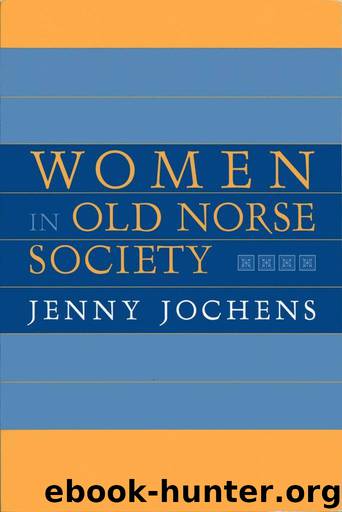Women in Old Norse Society by Jochens Jenny

Author:Jochens, Jenny [Jochens, Jenny]
Language: eng
Format: azw3, epub
Publisher: Cornell University Press
Published: 2014-12-01T16:00:00+00:00
Wool
By preparing and preserving food, women served immediate short-term needs. Whatever time remained after these chores was spent on the preparation of thread, cloth, and clothes, endeavors with long-lasting effects not only for the immediate families but also for the economy of the entire society.127
The female role in Icelandic material culture is highlighted by the importance and ubiquitous presence of homespun (vaðmdl) produced from sheep’s fleece. Clothing the entire population from cradle to grave and even occasionally protecting sick animals, homespun was also used for bedding, sails, wall-hangings, packs, and sacks of all kinds.128 Most impressive, it replaced silver as the standard commodity against which other products were evaluated within Iceland. As the country’s exclusive export, it procured necessities and luxuries only available abroad. The result, the unique system of “the homespun standard,” governed Icelandic economic life for centuries.129 I deal with the latter issue in the subsequent chapter; here, I am concerned with the production of homespun.
It is characteristic of the male perspective of the sources that although references to homespun as units of value are ubiquitous and information about the quality and measurement of the export cloth are full and detailed—al areas under male jurisdiction—the narratives are all but silent on the essential preliminaries of spinning the thread and weaving the cloth. As in most comparable societies, these tasks were almost surely performed by women, but it is difficult to substantiate this premise in detail. The solitary tasks of spinning and weaving rarely led to conflicts, did not demand legal attention, and did not reach the ears of storytellers, and thus bequeathed nothing but silence to law and literature. Other steps in the wool production required cooperation mainly among female workers, but these tasks do not surface in the sources, either, again implying that women’s disputes were considered unworthy of notice or perhaps even that women were less prone to quarrel over their work than men.130
Production of Cloth: Preliminary Steps. When settlers first arrived in Iceland they brought a few animals and limited supplies of food, clothing, weapons, and silver. With the food depleted before the clothes wore out, the two necessities of eating and keeping warm were accomplished sequentially but with an intervening delay, as men and women immediately set to fishing and gathering food, waiting for the domestic animals to proliferate sufficiently to contribute clothing as well as food. Skalla-Grímr, one of the first settlers, depended heavily on fishing and gathering because “in the beginning they had few animals compared to how many were needed, considering the number of humans” (Eg 2.29:75). Additional ships “laden with cattle” apparently arrived regularly (Lnd 1:235), and sheep and cattle reproduced quickly to provide dairy products, meat, skin, and raw wool in abundance.
Norwegian women brought to Iceland the age-old skills of spinning and weaving, which they had learned as children at home. Confident both of her own expertise and the availability of raw materials, one of the first female settlers refused to accept land as an uncompensated gift from a
Download
This site does not store any files on its server. We only index and link to content provided by other sites. Please contact the content providers to delete copyright contents if any and email us, we'll remove relevant links or contents immediately.
| Civilization & Culture | Expeditions & Discoveries |
| Jewish | Maritime History & Piracy |
| Religious | Slavery & Emancipation |
| Women in History |
Cecilia; Or, Memoirs of an Heiress — Volume 1 by Fanny Burney(32080)
Cecilia; Or, Memoirs of an Heiress — Volume 3 by Fanny Burney(31471)
Cecilia; Or, Memoirs of an Heiress — Volume 2 by Fanny Burney(31422)
The Secret History by Donna Tartt(18229)
Sapiens: A Brief History of Humankind by Yuval Noah Harari(13999)
Leonardo da Vinci by Walter Isaacson(12817)
The Radium Girls by Kate Moore(11639)
Sapiens by Yuval Noah Harari(5131)
How Democracies Die by Steven Levitsky & Daniel Ziblatt(4971)
The Wind in My Hair by Masih Alinejad(4852)
Homo Deus: A Brief History of Tomorrow by Yuval Noah Harari(4695)
Endurance: Shackleton's Incredible Voyage by Alfred Lansing(4518)
Man's Search for Meaning by Viktor Frankl(4300)
The Silk Roads by Peter Frankopan(4277)
Millionaire: The Philanderer, Gambler, and Duelist Who Invented Modern Finance by Janet Gleeson(4117)
The Rape of Nanking by Iris Chang(4025)
Hitler in Los Angeles by Steven J. Ross(3803)
Joan of Arc by Mary Gordon(3797)
The Motorcycle Diaries by Ernesto Che Guevara(3796)
